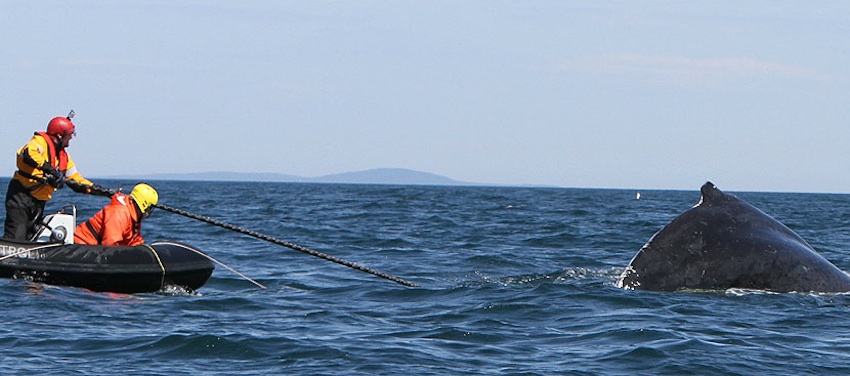Wildlife Officials: Don’t Be a Hero If You Spot a Struggling Sea Animal
When members of the Kennedy family spotted a sea turtle ensnared on a buoy along Nantucket Sound over the July 4 holiday, their first impulse was to approach it and free it from the rope that trapped it.
After speaking with officials from the National Oceanic and Atmospheric Administration’s Northeast Regional Office, Robert Kennedy, Jr., said he realized in hindsight what he did was not only risky for himself and the animal, it was also against the law.
Interfering and handling animals like sea turtles, which are protected under the federal Endangered Species Act, can lead to civil and criminal penalties and citations of up to $50,000—not to mention potential jail time—depending on the infraction. “Each case is different, and each investigation is going to be different,” said Logan Gregory, special agent in charge of NOAA Fisheries Office of law enforcement. “Fines can be issued depending on all the facts and circumstances involved. It’s good for people to know that we understand you want to help, but you may be doing more harm than good.”
The Kennedys avoided the steep fines that come with violating the federal law, but an investigation into why the animal was trapped is still ongoing, according to Gregory, who handles these types of cases. Their immediate reaction to save the turtle from its predicament is a common one, but it’s also something officials from NOAA are trying to get people to steer clear of for several reasons, especially in the summer months when run-ins with wildlife become more likely.
David Gouveia, the Marine Mammal and Sea Turtle Conservation Program Coordinator at NOAA’s Northeast regional headquarters, said the NOAA often gets painted in “a negative light” because they counter the public’s perception that helping an animal in distress is the best option. But the office is tasked with educating people as to why trying to save a wild creature can be harmful for all parties involved. “What we are trying to do, and what we have to do a better job of, is communicate with the public to let them know why. We aren’t just being the big bad government,” he said.

Brian Sharp, Provincetown Center for Coastal Studies, NOAA Fisheries Disentanglement Network Member, disentangling an endangered Leatherback sea turtle. Photo vias PCCS
The office’s investigations seek to learn what caused an entanglement, animal death, or injury in the first place, Gregory said. Officials collect as much information as possible about an event so they can prevent future occurrences that may harm marine wildlife. These investigations help NOAA protect the species and educate the public.
Gouveia said that if an encounter occurs, first and foremost, people shouldn’t get in the water. They should also keep a safe distance away from an animal because “bad things” can happen. “It’s a wild animal and stressed out, or certainly injured, and you can never predict its behavior. There are so many things that could go wrong,” he said, adding that the case with the Kennedys was a rare one, based on the success of the outcome.
Keeping in mind the safe space between a person and the animal, NOAA officials urge boaters or swimmers to use their smartphones to document the incident, so that they can later assess the problem more thoroughly. If they don’t have a phone, they recommend taking a mental snapshot of the environment. “People are trying to do the right thing. You want to help, and it’s a first instinct to be helpful. But it’s dangerous,” Gouveia said. “It looks successful in videos, but they are not always that way. We have professionals that go through rigorous training to handle these scenarios, and they are extremely, extremely dangerous. The recent ones have been successful, but they are not the norm. They are the exception to all disentanglements.”
The Deal With Seals
The seal population is abundant these days, so much so that some people have been toying with the idea of culling the herd. But since that issue is still just a blip on the proverbial horizon, human-to-seal interactions will continue to happen regularly, especially when pups are lounging onshore at popular beach destinations all along the Massachusetts coast.
Much like interfering with a turtle, Gouveia said seal pups can be just as hazardous. While the pups are not on the Endangered Species list, they are still protected by law, and officials are adamant that beach-goers and divers don’t step in the way of the livelihood of the pups.
Recently, there was some controversy over the New England Aquarium’s response to a seal pup in Marshfield after a couple from Weymouth tried to rescue the animal because they thought it was wounded by a shark. Like the Kennedys, that couple was also threatened with potential fines. Aquarium officials assessed the animal, and although they felt the seal was OK, others disagreed, causing some backlash. “The responding Aquarium Rescue Team staff and volunteers—with more than 15 years of experience responding to seals—determined the harbor seal pup did not have any shark bites. There were some small abrasions and some raised pustules, which are normal and found on almost all pups this time of year. Aquarium volunteers remained on site monitoring the pup until it returned to the water on its own,” officials said in a statement.
Seal sightings are common, as the animals are learning to feed and forage up and down the coast this time of year, and the aquarium fields frequent calls about them. While it is not usual for recently weaned pups to approach people, it’s in the pup’s best interest to leave it alone and let it learn to survive on its own, officials said. It is also against federal law to touch or harass the marine mammals, and equally as dangerous as intervening with a sea turtle. “If you are on the beach with a seal, keep a safe distance away, too. They are a wild population and if you approach it, it will bite you, and being bitten by a seal, even though it looks cute, you could get severely sick,” said Gouveia. “You’re dealing with wild populations and you can never predict their behavior in [their environment]. We have had a few close calls.”
For more information about what to do, and who to call in these situations, visit the NOAA website.



